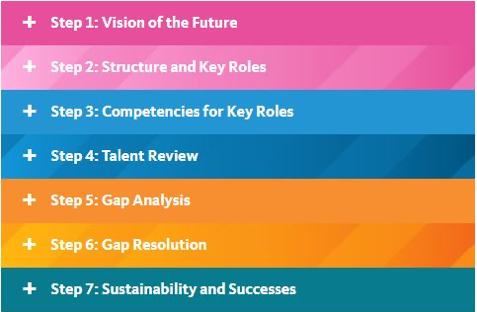Succession Planning
Succession planning is the process of identifying critical positions within your organization and developing an action plan to ensure the right people are in the right jobs, currently, and in the future.
A strong succession plan identifies future staffing needs and particular employees with the skills and potential to perform in future roles. This preparation strategy strengthens the overall capability of an organization by identifying key positions, highlighting potential vacancies, choosing critical skills necessary for your organization’s continuity, and focuses on developing individuals within your organization to meet your overall goals.
An even stronger succession plan includes developing employees from all groups and keeps diversity and inclusion at the forefront of this process. Identifying positions and individuals using equitable practices, ensures that an organization’s growth does not disproportionately and unfairly impact certain groups of employees. It is suggested that during the assessment stage of succession planning, incorporate the organization’s diversity goals when identifying position needs. Also, when developing and tracking metrics of your plan, record the diversity of qualified applicant pools for key positions, in order to analyze the progress made in the future.
The University of California outlines the topic of Succession, Organizational Readiness & Retention on the UC Net website, noting how to stay current with the rapid rate of change and talent mobility. They cover an effective readiness strategy that encompasses seven steps (see below).

For further explanation of each of the seven steps and additional resources, visit the Succession, Organizational Readiness & Retention page.
For Further Reading
- The Critical Importance of Succession Planning by Nancy Rodgriguez, Chief Administrative Officer at Geffen Academy (as part of the AVC Monthly Management Tips)
- Goal Setting and Professional Development by Jack Bracken, Jack D. Bracken, Research Safety Training Manager for UCLA Environment, Health & Safety (as part of the AVC Monthly Management Tips)
Employee Retention
Most people understand what diversity means, but inclusion can be a bit harder to understand in the context of employees and employee retention. Inclusion is the degree to which diverse individuals are able to participate fully in an organization or group. It includes the behaviors that embrace and promote diversity of voices and identities, and ensures everyone is treated fairly and respectfully, despite differences.
From a professional perspective, inclusion is about how employees interact. Are their ideas well-received? Are colleagues uplifting to one another? Do employees offer each other constructive feedback? As a manager or supervisor, the key to inclusion is to understand who your employees are and to create an environment where they can be who they are. If employees feel that their values, distinct talents, and perspectives are included in the organization, they will want to stay. To find out more about employees, use tools such as engagement surveys, focus groups, and personal conversations.
With this information, the concept of belonging can be employed within the organization. Belonging is the experience of being wholly accepted and included by those around you. It centers around an employee feeling accepted in the workplace. Every team member should feel that their perspective is valued and adds something useful to the organization.
A simplistic example of belonging in the workplace, is if a leadership team is composed of nine seasoned managers and one new manager. This situation could make the new manager feel like an outlier, with little value to offer to the team. However, if the other managers actively encourage the new manager to voice their ideas and provide equal opportunity for the new manager to lead projects, this will help them to feel valued and respected. These simple actions and others like it, will keep employees engaged and make them feel that they belong in the organization.
For Further Reading
- Retention and Sense of Belonging by London McBride, Crime Prevention Officer, UCLA Police Department (as part of the AVC Monthly Management Tips)
- Developing Represented Staff by Jessica Doty, Assistant Manager-Employee & Labor Relations for Campus Human Resources (as part of the AVC Monthly Management Tips)
